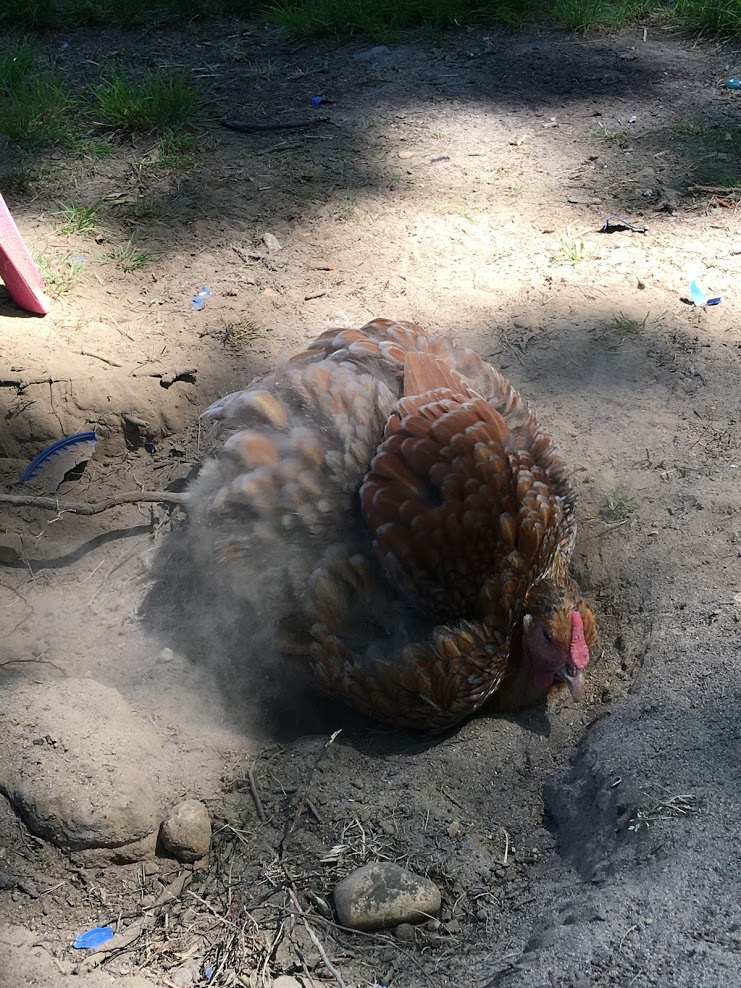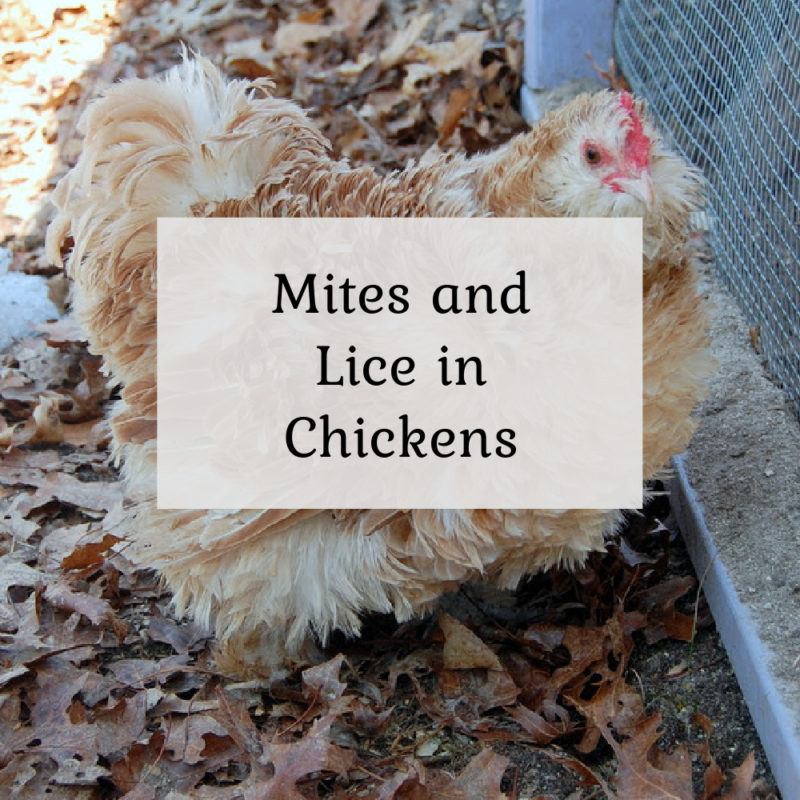---------------------------------------------------------
Unfortunately, when you keep animals outdoors, you don’t have as much control as you do with your indoor pets. Wild birds roost in your trees or swoop down to forage in your grass with the flock, rodents or squirrels visit the coop while your birds are out free ranging. It’s just a part of keeping chickens. I used to love when wildlife would visit my yard, but they can bring parasites and diseases to your flock.
Parasites are unpleasant, but as long as you catch them early it doesn’t have to be a big issue. And don’t take it personally, it doesn’t mean you are doing anything wrong or that your coop is filthy. Properly cleaning & maintaining your chicken area is an important step in preventing infestations, but sometimes it happens anyway. You should always take an infestation seriously. Left unchecked, a light infestation can turn into a full blown emergency in a matter of weeks. Many parasites are blood suckers. When a bird has a large amount on her body, it can lead to anemia and eventually to death.
There are dozens of kinds of mites & lice varieties that can bother your poultry, but let’s take a closer look at the most commonly found kinds. The good news is most of these bugs are not interested in a human meal, they might occasionally bite you in a severe infestation, but they likely will not infest you or your house.
External Parasites to Look For
Red Mites
These creepy little buggers like to come out at night, so the best time to check for them is at roosting time. Look under your chicken’s wing, near their vent and also around the coop. During the day, they will hide in the cracks & crevices of your coop or underneath the roosts. Then when the chickens are bedded down for the night, they come out for the feast. Like most mites, they are out for blood.
Red Mites are super small so you will need a flashlight and some patience to see them. Part the chicken’s feathers so you can see down to the skin. Red mites are grey before they have fed and smaller than a grain of sand with eight tiny legs. After feeding, when they are full of blood, they are a reddish pink.
If you see one or two, now is the time to act before it gets worse. When you see 6 or 7, the bird likely has thousands of mites. More than that and the bird’s life could be in serious danger. This type of parasite generally will not lay it’s eggs on the bird, instead laying them in the coop. The mites might not be active during the day, but the reactions from their bites can be seen all day in your flock.
An infected bird will be itchy and be excessively preening, possibly pulling out her feathers, especially near her vent. A bird suffering from anemia from a severe infestation will have a pale comb, be listless, and have reduced egg production. Red Mites are usually found spring-fall unless you live in a temperate climate. They do not die in the colder weather, however, they go dormant and can live over 6 months without feeding, just hiding in your coop!
Treating Red Mites
Because they can lie dormant for so long, it is important to treat both the flock and the coop. When you suspect an infestation, completely empty the entire coop. Use a vinegar spray to clean, then spray permethrin or Elector PSP in all the nooks & crannies and under the roosts. To treat the flock you can sprinkle them with DE (DiatomaceousEarth). Be sure it gets under their feathers to the skin and remember to wear a mask so you don’t inhale the particles. Chemical parasite treatments, like oral or topical ivermectin or Elector PSP, are also available and are very effective in combatting infestations.
We have used Ivomec Eprinex to treat the birds when there is an infestation. It is similar to Frontline for dogs, you apply the drops in between the chicken’s shoulder blades. Within hours you can see visible relief on your hens. For standard chickens, use 0.5 cc dropper (.25 cc for bantams), applied topically on the back between the wings. You will want to reclean & possibly retreat the flock in two weeks to get any new mite eggs that have hatched. We have never had to retreat the flock, one dose is usually enough.
Northern Fowl Mites
The symptoms of a Northern Fowl Mite infestation is similar to Red Mites – itching, excessive preening, missing feathers, anemia, pale comb, listlessness and decreased egg laying. They are slightly larger than Red Mites, but still super small and hard to see. The biggest difference is these parasites live on the chicken. They can only survive a few weeks without a blood source.
This makes detection a little easier because you can check for them during daylight hours and in addition to the live mites, you can often see their nits (eggs) gathered at the base of feather shafts. You’ll want to carefully part the feathers to check down to the skin to find them. The life cycle of Northern Fowl Mites is under a week – so they are laying thousands of eggs every week, multiplying quickly. Treatment is the same as Red Mites. Clean the coop for good measure (yes they don’t typically live in the coop, but they can for short periods of time) and treat the flock with a parasite treatment. You will want to repeat this weekly for a couple weeks to ensure you kill all the newly hatching mites.
Scaly Leg Mites
These creepy crawlies, as expected, live primarily on your chicken’s legs & feet. They are too tiny for human eyes to see, but you can see the evidence they have been there. These mites burrow under the leg scales eating skin cells & tissue and depositing their waste. All that waste builds up, pushing the leg scales out, making them look thick and crusty. This can be very painful to the chicken and if left untreated can cause deformity and lameness.
Treatment isn’t difficult, but it can take a long time to successfully eradicate. The most common way to treat the effected bird is to sit her in a warm bath with Epsom salt for about 15 minutes to soften the scales, then take a soft, old toothbrush and gently scrub the legs. Next sit the bird in a vegetable oil bath to suffocate the mites. Finally, totally cover the legs in Vaseline to further suffocate old mites & protect against new ones. This treatment will likely need to be repeated weekly for a month or longer. For severe cases, you might want to consider adding a topical chemical parasite treatment.
Poultry Lice
Very similar to mites are poultry lice. They are not the same kind of lice that infest humans, they will likely leave you alone. But they behave similarly to human lice. They live their whole lives & lays their eggs on the chicken & in their feathers. They are beige, super small & super fast, making them difficult to see on light colored birds. You will likely see nits piled up at the base of feather shafts, particularly near the vent area. Lice are not blood feeders, rather feeding on skin cells and feathers.
Lice will make the bird itchy and uncomfortable, so just like with mites, symptoms includes itchiness, excessive preening & feather loss. Likewise, treatment is the same. It’s always a good measure to give the coop a complete cleaning when dealing with any parasite, even though lice don’t live for long when off the bird. Treat the entire flock with a chemical treatment like Ivomec Eprinex or Elector PSP. You will want to repeat the treatment in two weeks – and possibly again at one month in severe cases to get any newly hatched eggs.

Prevention
Is your skin crawling yet? Mine is! Obviously, preventing an infestation is far easier than treating one. Luckily, your birds are ready, willing, and able to help in this area. One of the best ways to keep parasites away is dust bathing. When the birds get the rough sand particles under their feathers, it irritates pests and in some cases can even cut the invaders causing them to die.
Be sure your chickens always have access to loose, sandy soil to dust bathe in. Want more information on dust bathing? Click here! You don’t need to add anything other than sand to a dust bathing area. Some chicken keepers like to add food grade DE to their dust baths. While it can sometimes be effective in eliminating pests without chemicals, it is not without it’s dangers, particularly to you & your chicken’s respiratory system. I personally think it has it’s place when you KNOW you have a problem, but it isn’t something that should be used on a regular basis.
Other things you can do to limit the parasites in your flock include being sure to quarantine any new birds you add. Practice good biosecurity yourself (not sharing tools with other farmers, not allowing other chicken keepers in your flock’s area, having a specific set of shoes and/or clothes for chicken keeping)
Keep your flock’s immune system healthy! Good quality feed, fresh healthy vegetables and protein rich seeds & mealworms all contribute to an overall healthy bird, capable of fighting of disease & parasites!







Janet Guyll
Saturday 26th of August 2023
I have a black star hen. She started acting like she was having trouble walking. Her feathers are still shiny. Her cone is discolored and she has white stuff behind her mouth like between her mouth and her neck and she just lays around but she looks fatter than normal Walking. She just doesn’t walk very good.
Liz
Sunday 27th of August 2023
It's so hard to say what that could be. Have you checked her for mites by examining her skin? You mentioned she was having trouble walking, that could be weakness from mites or internal parasites, but it could also be bumblefoot. Check the bottoms of her feet, bumblefoot infection looks like little black scabs. I would suggest you check out this post and see if any of these issues seem to fit your girl: https://thecapecoop.com/help-chicken-sick/
Michael
Thursday 2nd of March 2023
Hi Liz, In your article you refer the the topical treatment as "Ivomec Eprinex" which is a hyperlink that can no longer be found on Amazon. After googling "Ivomec Eprinex", I discovered what I thought was "BrandName ProductName" is actually two different products: Ivomec (Ivermectin) and Eprinex (eprinomectin). I'm not sure what the difference between those two active ingredients is but I wanted to know if you have a preference. Thanks
Liz
Tuesday 7th of March 2023
Hi Michael, thank you I'll have to update the hyperlink. Both ivermectin & eprinomectin will work to kill worms & mites in chickens. Just be sure you are purchasing the topical versions and not the injectable versions. The type I usually use is Eprinex (active ingredient eprinomectin). Here is a link from Walmart PetRX: https://www.walmartpetrx.com/p-2164-ivomec-eprinex-pour-on.aspx
Michael
Thursday 2nd of March 2023
Well, like Roseanne Roseannadanna used to say, "Never Mind". I was thrown by the fact that both the Ivomec and Eprinex products are produced by the "Ivomec" company. So there is "Ivomec Ivomec" and "Ivomec Eprinex". BTW, great article.
Julia Ricks
Monday 9th of August 2021
I free range my chickens and ducks, I just found mites. :( I cleaned out my entire coop. Should I be concerned about my other areas on my property? I guess what I'm asking is do I need to spray anything around my acre to help get rid of mites? I don't want to use any pesticides if at all possible. Thanks
Liz
Tuesday 10th of August 2021
I wouldn't. They tend to stick close to where their food source is so treating your flock & cleaning out your coop should hopefully end the problem. Good luck!
Shannon
Sunday 24th of January 2021
Hello, I just treated all of my flock for lice with the pour on ivermectin, how long does it take to kill the lice
Liz
Monday 25th of January 2021
I've found within 24 hours there is a huge, visible relief in the flock. Check them all again after a couple days. I've never had to retreat them, it usually knocks the bugs out in one dose
Lindsay
Thursday 5th of November 2020
Is there an egg withdrawal period when treating with eprinex? So far I have only had to use it on my rooster who lived with only one hen (who unfortunately passed away this week, my first loss of a chicken after raising them for almost two years 😩). I need to move him to a new coop with some new ladies so he isn’t lonely but I’m worried about him spreading the mites to them and having to treat them as well and creating a bigger problem. Thanks for this article!
Liz
Monday 9th of November 2020
Hi Lindsay, since Eprinex use in chickens is "off label" the manufacturer does not specify withdrawal periods for laying hens. It is meant for use with cattle, and in cattle there is zero withdrawal time for both milk & meat. To be extra cautious though, anytime I have treated my flock I have tossed the eggs for two weeks. It stinks wasting all those eggs, but I always think it's better to err on the side of caution.